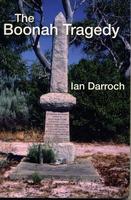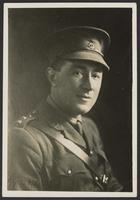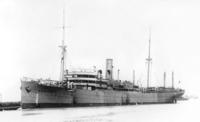
South Australian Medical Heritage Society Inc
Website for the Virtual Museum
Home
Coming meetings
Past meetings
About the Society
Main Galleries
Medicine
Surgery
Anaesthesia
X-rays
Hospitals,other organisations
Individuals of note
Small Galleries
Ethnic medicine
- Aboriginal
- Chinese
- Mediterran
The Boonah Tragedy
Acknowledgements: We are most grateful to Dr. Tony Swain for allowing us to add his presentation to "noted persons".
Presented by Dr Tony Swain to the Defence Health Triumvirate - SA, 2013 Conference; Adelaide, June 29th 2013.
Dr Swain, a retired anaesthetist and retired Surg LCDR RANR, is a member of the Military Health Services Historical Research Group of SA. This Group is currently preparing a study of the Drs and medical students from SA who enlisted in WW1 with the view of publication during the centenary of the war.
 |
 |
| FRONT COVER OF IAN DARROCH'S BOOK |
CAPTAIN GILBERT BROWN, 1914 |
In 1912, a youngish 29 year old Dr Gilbert Brown from Wigan, Lancashire, England arrived in Adelaide and took a position as Surgeon in a triangular practice in Snowtown.
He had graduated with MB ChB, University of Liverpool, in 1908, and his pre migration experience included House Surgeon and House Physician at the Royal Infirmary, Liverpool; House Surgeon at the Hospital for Women, and SMO at the Children's Infirmary, Liverpool.
Two years later, in 1914, he was joined in Australia by Dr Marie Simpson (herself a graduate of Medicine of London University), the couple married upon her arrival in Adelaide and they lived at 31 Watson Ave Rose Park.
After war broke out in 1914, Gilbert Brown applied for a commission in the AIF on the 15th of July 1915; however he was to carry on the General Practice of all members of the partnership until 1918 when he was free to enlist. He was recommended for general duties on 11th of September, 1918, and sailed in His Majesty's Australian Troopship (HMAT) Boonah from Port Adelaide on 22nd of October, 1918, bound for the UK via Fremantle and South Africa.
The ship carried 30 members of the Australian Army Medical Corp (AAMC) led by two Medical Officers, the senior being Captain T. B. Clouston, and his junior Capt Gilbert Brown. They were affectionately known as "Big Doc" and "Little Doc". "Big Doc" was an Irish born 40 year old 1906 graduate of Sydney University, who stood 6ft 2ins (1.8m) tall and weighed 16st (102Kg) with a chest of 48ins (120cm). "Little Doc" was only 35 years old, 5ft 10 ins (1.7m), 13st 3lbs (84Kg) and a chest of 38ins (96cm). Clouston had post graduation experience as a GP in Tumut, NSW, and lately as the MO for the Sanitary Service to the construction camps for the Cataract and Burrunjack Dams in NSW.
HMAT Boonah was built in Germany in 1912 for the Australian trade, and known as the Melbourne. She was in Sydney on the outbreak of war in 1914, and seized by the Commonwealth Government, renamed Boonah, and hastily converted to a troopship. She was the last Australian troop ship to leave Australia in World War 1. Carrying about 1200 AIF soldiers, she arrived in Durban, South Africa just three days after the armistice was signed, and on hearing the news, made arrangements to promptly return home.
Before her departure however, local stevedores from the Spanish 'flu stricken city infected soldiers who were billeted in crowded conditions throughout the ship. Another troop ship, the Wyreema ex England with a contingent of Australian Army Nursing Sisters on board had departed South Africa two days ahead of the Boonah, and remained in radio contact throughout the eastward return journey across the Indian Ocean.
After leaving Durban, the Boonah experienced harsh weather conditions, cold temperatures, icy decks, and rough seas; and for the soldiers, two thin issue blankets in an unheated ship in a swinging hammock. Life was very uncomfortable. These conditions confined the Ships Company and troops below deck for many days of the return home voyage. After 5 days the first indications of the 'flu appeared, at first suspected by the medical staff to be mild tonsillitis, but later symptoms of lower back pain which spread to other limbs, raging headaches, nose bleeds and fever often exceeding 104°F (40°C) soon forced all on board to assume the worst. The troops' responses were varied with many showing gradual withdrawal into themselves maintaining a wall of isolation for themselves and the virus. Every night as they prepared for sleep, each was faced with the dreadful uncertainty of waking next morning in the grip of the fearful disease. Each day the sick parades got longer and longer, a fumigation chamber was hastily constructed and routines established to manage the spread of the 'flu throughout the ship.
The Boonah's Captain had a dilemma: with 37 members of his crew affected, many of them stokers, he had to reduce speed as there was insufficient crew to load the boilers. Volunteers were called for. This also meant the rationing of provisions and drinking water for the longer voyage.
The first casualty was Staff Sgt Thwaites of the AAMC.
The Troop Ship Wyreema's Commanding Officer wrote: "The Western Australian Commandant asked me to land twenty nursing sisters at the Quarantine Station. Volunteers were called for and there was not only a ready response but so many offered that it was necessary to place the names in a hat and draw the twenty required. They knew perfectly well the enormous risk they were taking. Yet they were eager to undertake the work and those whose names were not drawn were disappointed."
By the time the Boonah had arrived back at Fremantle on the 12th of December, more than 300 cases (nearly 25% on board) had been reported and Commonwealth immigration authorities initially refused to allow the soldiers to disembark, knowing of the global pandemic which was under way, but which had until then spared Western Australia.
The ship anchored in Gage Roads and after some delay before approval was granted, 300 of the most unwell soldiers were ferried ashore to the Quarantine Station at Woodman Point, south of Fremantle. Three men died on the first day at the station. The condition of some deteriorated further with more dying as well as more than 20 nursing and medical staff becoming infected.
Meanwhile, on board ship where most of the men remained, conditions were said to be deplorable. A seven-day incubation period with no new cases was required to prove that the disease had burnt itself out, but new infections and deaths continued, caused by the cramped and close living conditions. Public outrage grew against the refusal of the immigration authorities to allow all of the soldiers ashore with casualties growing each day. Wrangling between the State Minister for Health and the Federal immigration authorities continued, and tensions increased to the point that the Returned Servicemen's Association made threats to storm the ship to return the sick men to shore.
After nine days of acrimony, and despite breaking quarantine regulations, the ship was ordered to depart, presumably to defuse the situation.
Another 17 cases were discovered between Albany and Adelaide, and the remaining men were disembarked at Torrens Island Quarantine Station. No further deaths occurred, and after being given the all-clear, the remaining men returned to their homes. A total of twenty-seven soldiers and four nurses at Woodman Point, WA, died of influenza during the crisis.
Gilbert Brown must have feared every day that his number was up.
The AAMC staff on board must have used every precaution available to protect themselves for they were managing the crisis under the most disadvantaged environment ...................... all credit to them.
In the book: "1918 Influenza, The Mother of all Pandemics" from the Center of Disease and Control and Prevention, January 2006 comes the confirmation that the virus was a H1N1 strain, it affected 500 million people with mortality of 50-100 million people; somewhere between 3-5% of the world population.
Gilbert Brown's appointment was terminated in September 1919. He was issued with the British War Medal and the Victory Medal.
Back in civilian life, the softly spoken retiring Gilbert Brown entered into the social life of Adelaide. They moved to Walkerville Tce, Gilberton where they both practiced. He was described as "typical North of England country gentleman. He had a kindly manner and simple taste and always well groomed being meticulous in the care of his clothes which were mostly tailored for him by Walker of Albermarie St, London".
Gilbert Brown was a pioneer of modern anaesthesia in Australia. He was appointed Honorary Anaesthetist, Adelaide Children's Hospital and the Royal Adelaide Hospital. He was not a politician anaesthetist, but had a firm faith in the future of anaesthetics as a speciality. From the start of this career "he kept a record of every anaesthetic he administered. These contained comments which were on some occasions critical and others amusing. His records became almost an obsession with him. He had them bound in annual volumes" which have been retained by the Australian Society of Anaesthetists.
His influence of the progress of anaesthesia in South Australia was profound. He was the first president of the Australian Society of Anaesthetists in 1934. In 1953, he was appointed a CBE and also Officer Brother of the Venerable Order of St John of Jerusalem (OStJ).
He died in 1960.
He has been honoured by the Speciality with the:
Gilbert Brown Prize; ANZCA
The Prize was established by the Faculty of Anaesthetists, RACS in 1961, just one year after his death, and shall be awarded to the Fellow judged to make the best contribution to the free research paper session named the Gilbert Brown Prize Session at each Annual Scientific Meeting.
And the
Gilbert Brown Award: by the Australian Society of Anaesthetists, the ASA. Established in 1969 as a result of a suggestion of Dr Mary Burnell, the Award is intended to perpetuate the memory of the first President of the Australian Society of Anaesthetists and maybe awarded to any individual for outstanding and particularly meritorious service to the Society.
Sources:
- National Archives of Australia service record.
- The Boonah Tragedy by Ian Darroch. ISBN 0 86445.
- MJA; April 20th, 1960, p708,
- Fifty Years, ASA 1934-1984, Gwen Wilson,
- Photo, Family Collection SLV,
- A History of the Royal Adelaide Hospital by J Escourt Hughes, 1967
- National Library of Australia's Trove.
- Taubenberger, Jeffery K.; Morens, David M. (January 2006). "1918 Influenza: the Mother of All Pandemics".
- Centers for Disease Control and Prevention. doi:10.3201/eid1201.050979. Archived from the original on 1 October 2009. Retrieved 9 May 2009.
-o0o-
